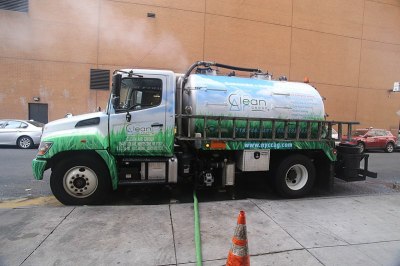Anyone in the restaurant industry can tell you that almost nothing is worse than grease clogging up pipes or backing up a drain. Unfortunately, not many plumbing businesses can specialize in this particular challenge, meaning that getting the job done, and done right the first time, can be a difficult task at best. That’s why it’s important to make a smart choice when deciding how to do your grease trap cleaning.
When It’s Maybe Already Too Late to Clean or Service Your Trap
Fat and oil buildup in restaurant plumbing systems inevitably lead to grease blockages. If it’s especially large, a back-up can shut down an establishment for a full two days, leading to significant loss of profit. Grease trap cleaning is a messy business, as sludge can regularly build up to two inches in thickness or more if left unattended.
Plumbing Issues Caused by Grease and Oil Build Up
If you don’t manage your plumbing properly, you might have a clog that causes grease to back up.
Plumbing issues can happen to any commercial kitchen or restaurant. Older systems end up being integrated instead of your grease trap having a separate line and a backup could impact everything.
If the grease trap starts to back up, your entire restaurant could be filled with a terrible odor and send your customers packing. Make sure your entire plumbing system stays free from blockages. Failure to manage your plumbing could lead to an issue and a loss of customer support.
Additional issues such as a foul odor and disposal difficulties can emerge. The cleaning process is intensive; the grease has to be scraped off the sides, lids, and bottom of the grease trap. When choosing someone to clean, make sure they have all the appropriate gear and requisite knowledge to do the job properly. Locate a reputable and licensed grease trap cleaning service in your local area and ask for job references and proof of insurance.
Emergency Grease Trap Repairs
Of course, grease trap cleaning is one of the many problems a restaurant can face. Leaks, sewer odors, and heating fluctuations can strike suddenly, leaving customers unhappy or even shutting down the whole kitchen. As people in the industry know, all it takes is one bad experience, and a customer may never return. With this in mind, it is important to develop a rapport with a plumbing company that will take care of its clients at the drop of a dime.
How Do You Know When Your Restaurant’s Grease Trap Needs to be Cleaned or Pumped Out?
5 Signs Your Restaurant’s Grease Trap Needs Cleaning
1) When your restaurant’s drainage plumbing system is clogged or slow-moving.
2) When grease is 30% or more the total liquid depth in the trap or tank.
3) When there’s a foul smell coming from the kitchen, dishwasher, or sinks.
4) When it’s simply been too long since your last grease trap cleaning or inspection.
5) When you find grease in unusual places you never imagined.
The Process of Cleaning Out Grease Traps
Grease trap cleaning is the process of removing grease waste and other food particles from the unit. It is possible to clean grease traps on your own, but it can be a very difficult and messy job. Hiring a professional grease trap cleaning service to clean your grease trap is the best course of action.
While grease can be the nastiest thing to clean, it’s important to use the proper chemicals and cleaning products to make sure no food is tainted and that all equipment is in top-notch condition. A professional vacuum and grease solvents can help, depending on the situation. Make sure to ask which solution would work best for your business.
New Grease Trap Installations and Replacements
In the fast-paced world of restaurant ownership, having an efficient plumbing system is the backbone of success. The best option, often, is to invest in plumbing equipment so that you aren’t stuck with an unexpected disaster.
Most importantly, installing a grease trap that doesn’t allow fast build-up causes peace of mind, along with a garbage disposal that doesn’t jam up at inconvenient times. Upgrading to efficient fryers and grease disposal systems can help stop problems before they arise.
At worst, grease can combine with soap during an improper clean-up procedure, which could cause an employee or customer to slip and fall. Grease an cooking oil fires, as well, are notoriously hard to extinguish and can destroy any restaurant, along with its reputation.
Innovative Modern Grease Trap Designs are On the Horizon
Double Baffle Passive Grease Traps
Read more on environmental wastewater management and septic tank pumping here.
The best tip for dealing with grease is not to wait until it is an emergency and to start taking preventative steps as soon as possible.
Read more on grease trap cleaning here.
from Ed’s Environmental Blogger https://edwardhorbachukiii.blogspot.com/2020/05/grease-trap-cleaning-procedures-and.html
https://edwardhorbachukiii.blogspot.com/
From https://edwardhorbachukiii.wordpress.com/2020/05/15/grease-trap-cleaning-procedures-and-maintenance/
from
https://greasetrapcleaning1.wordpress.com/2020/05/15/grease-trap-cleaning-procedures-and-maintenance/


No comments:
Post a Comment